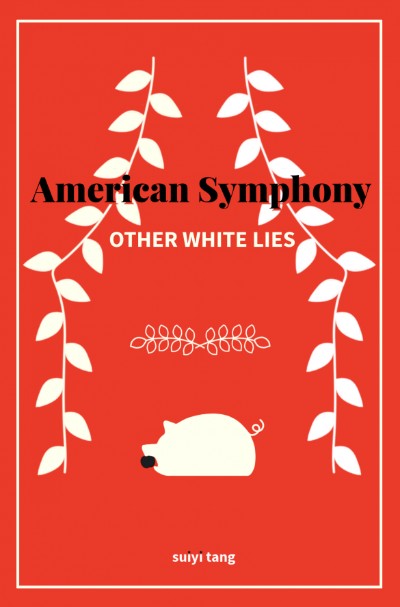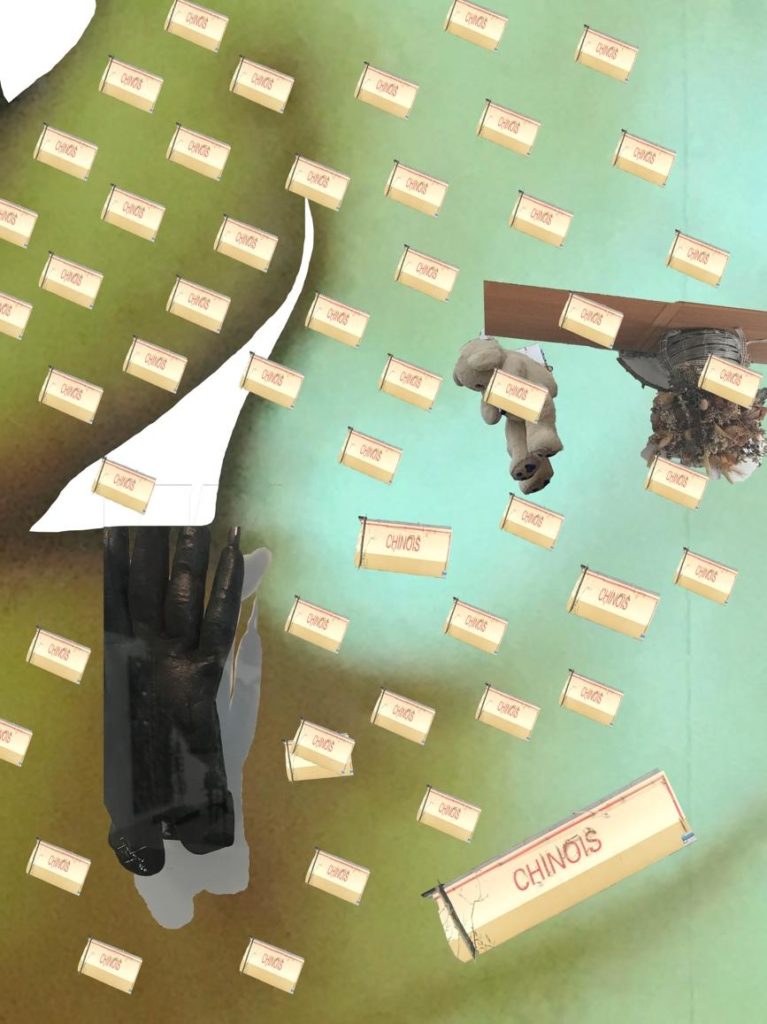
We’re thrilled to present an excerpt from Suiyi Tang’s forthcoming book American Symphony: Other White Lies, due out this fall on #RECURRENT/Civil Coping Mechanisms. The publisher describes it as follows: “American Symphony is a portrait of a portrait, a mirror’s reflection of someone that’s gone missing, a speculative memoir that takes cues and challenges from works by Kathy Acker, Theresa Hak Kyung Cha, and Jenny Zhang.”
*
Bloom
“You see,” the difficult conversation would begin, “I am actually a flower.”
Not that she’d ever have the opportunity to broach the question. It would be many years, and several dimensions before she realized the myriad of ironies which accompanied her during her nomadic months in Europe. Few know of this period in S’s life, wherein she had followed, first a boy, then, a book, and finally, a clinging sense of desperate ennui from the Amalfi Coast to Cote d’Azur, to Nordic Tundra, and back again. The things which followed her: a worn copy of I LOVE DICK, a craving for intimacy, the unknown diagnosis and subsequent exile—these were trials she faced in paradoxical isolation, the incidents themselves transforming into pestilential epicenters of her life while terrain and movement seemed to vanish before her feet. In particular, it was on the stage of fucking that she waged her revolution, or, more precisely, revolution was waged upon her, and her corpse enlisted as half-conscious foot soldier. So it made sense, that these months abroad signified little in the grand scheme of S’s comprehensions, and that she took care to conceal their true events from the sweeping eye of the few interested in her life.
Maximum pleasure—was that what she was after? Or, pursuit of power—reverie, desire, respect (for wasn’t even the rudest desire an admission of need, and therefore, vulnerability?)—which could only be afforded on the stage of fucking (consummation being, she realized, slightly less dismissible than the care afforded by fleeing attraction). But, oh, now that it’s all over, we see that she wouldn’t realize the impact of her naïf submissions until it was far too late.

The first pulse came in Milan. She had ignored it, in favor of denial paved by repression. But by the time she reached Vienna, the virus had flowered into an uncontrollable stem of poison so potent that she could do nothing but resign herself to the gynecologist and florist, in that order. The doctor didn’t know what it was, only, they whispered to her behind musty doors, she was not the first. The garden, it seemed, was the best-kept secret in all of Europe; a second spring that folded within the cotton lining of her moist jeans. Now that the seed had been sowed and the first bloom undoubtedly on its way, there was nothing they could do save confinement, daily watering, and a diet of anti-viral pills which both she and they knew would do little to snip the bud. Perhaps it was an oversight on part of her caregivers: the sight of the dipping bud, gazing from her cavern, was a precious sight indeed—to snip it clean off was a violence unthinkable. What would the girl be, in the aftermath of this theft?
So she submitted herself, once more, to the cotton expanse of the bed and the army of probing fingers until one clear morning, she felt the first pangs of pain in her lower abdomen and a pillow of dirt beneath her head. Hurry, she called to the nurse, it’s on its way. when the team of botanists wheeled her out of the operating room, her face had been replaced with lilting petals of a venomous red, which spilled out of her mouth until their soft skin covered eyebrow to chin. Her gentle heaves emitted no sign of pain, but, in the absence of face, we cannot be certain that the operation was without failure (slight mishap, it is said, is known to have been common amongst these mid-century botanical experiments). A violet stain unfurled the spot of the pubis, and it, too, quivered with every sigh. At the edge of perception, by a corner of the bed frame, a single vine curled from beneath the blanket and wrapped itself around her toe. This was how they’d identify her—Girl With Vine On Toe, specimen 378—when the time came for burial.
They laid her in the soil on a Tuesday, beneath clouds that wavered on the edge of dissolution. At first, her foot wouldn’t fit into the pot-sized hole they’d dug. Oh, dear, she’d thought, that hurts. By the time that her lower body was fitted into the plot, however, she had grown tolerant of the stinging sensation that marked neural attachment to the host. When they were done, only her bare torso was visible, above a shadow of a bush at the opening of her legs. She leaned back against the brick wall and stared serenely at the planters, slivers of pupil visible from behind the curtain of petal. In place of tongue, she now had long, snaking stem, so that she could no longer talk, but could taste the atmosphere and the tone of the conversation around her. Disappointment bordering on bitterness, one smacked; relief that tasted like the mild-sweet of honeydew, another. Every day, the procedure continued: daily watering, a dash of fertilizer around her waist, inspection by the botanist, then the surgeon, and finally, the Feeding. The team of scientists set up a camera at the base of her plot. Day in and day out, they monitored her measurements. She could no longer feel the cold nor gaze upon her as she used to; only, when it came time for her daily medication, she sensed a writhing start from the base of her pubis that ended in a ringing at the top of her head. Her body, as if it possessed a volition of its own, would begin turning and twisting, until her arms thrashed with the same elegance as the stem that rose from her lips. The botanists took note; the surgeons, with their thickly gloved hands, patted the clump of dirt lining the point of contact between her hip and soil, finding that she had settled so completely that no arbitrary division now existed. It was then that they stopped the anti-viral treatments, and allowed
venom red petals to bloom without interruption.
On the hundred and fifth day, she woke from a dream and saw the sky for the first time that she could remember. A tickle sounded in the back of her throat, and, she found, to her surprise, that when she mimicked the gesture of coughing, a deep rattle sounded in the back of her throat. By the hundred and tenth day, her sound box had been rudimentarily restored, and simple phrases had returned to her vocabulary. The venom red which had previously occupied the full terrain of her mouth now receded, and she found that, on good days, she could momentarily will its retraction. “Where am I,” she muttered. Or, “I want to go home.” But when prodded about the precise location of “home,” she found that she could not remember, or didn’t know, or was perhaps purposefully evading the question on behalf of her guarded subconscious, who knew then, as in the remainder of her life, complete evacuation of normality would ensue at the sight of discovery. It was as if the id hoped, when no other part of her could, that some semblance of normality could still exist after the ordeal. but what normality was, it no longer knew.
She was discharged on the hundred and fiftieth day. Discharged, for that was what the surgeons insisted on calling it, but the botanists preferred deracination, a term which they repeated slowly to her until she could form her swollen lips around the syllables, and too proclaimed it with a jubilance she had almost forgotten. They knew little about the disease, but from the samples they had taken, they told her this much: she was a viral carrier of a lethal concoction, which meant that she was, firstly, contagious, secondly, subject to sporadic periods of blossoming, and thirdly, strapped to the anti-viral medication for the rest of her life. The flower remained, though they clipped its edges. Former subjects, a nurse had whispered to her, had been subject to the complete decapitation of their buds. But they found that, once castrated, they lost, too, the function of their voice, having been left only with a wilting stem in lieu of epiglottis and tongue. They swore her to secrecy, but, as we know, that was hardly necessary. when she left the site of the clinic, it appeared, on the surface, as if she had never entered it. Trace evidence remained: for the rest of her life, she was obliged to inform the few partners she took of her condition, and postmortem interviews revealed that, during moments of peak emotional volatility, a red glow would rise from the back of her neck into the space above her crown, establishing the visage of a halo, or a blood-like taint, or a pair of devil’s horns. She was never straightforward about revelations of her condition, preferring instead to open her mouth and will the bloom. “Unfortunately,” she would say, “I am actually a flower, viral at that.” For this reason, among others, she remained a mostly solitary figure for most of her life, a fact her less informed biographers attributed to her intense occupation with the liminal, or her drug use, or general acerbity for which she became known, in the intimate society that failed to attend to her. Why we take interest in her today is a fact beyond me, but, this condition, known colloquially as toxicum genetrix, is now successfully immunized.
Follow Vol. 1 Brooklyn on Twitter, Facebook, and sign up for our mailing list.
